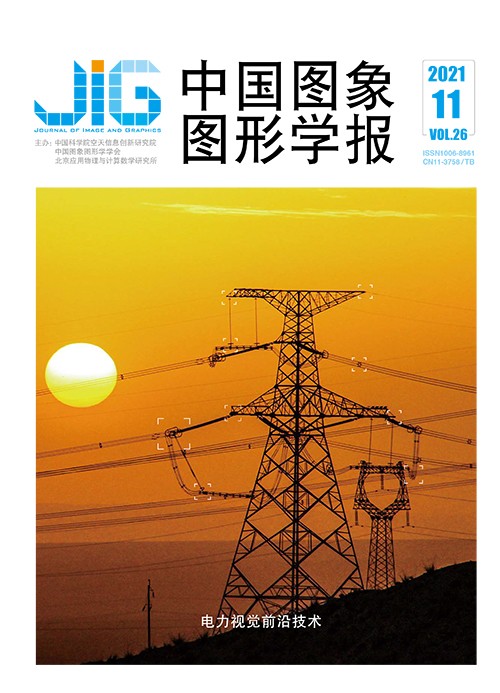
面向改进尺度缩放网络的绝缘子识别
摘 要
目的 在电力系统中,准确地识别绝缘子目标是保障输电线路正常运行的重要前提。针对传统方法无法自动提取绝缘子特征,以及深度学习网络提取绝缘子语义信息不足的问题,提出了一种基于改进多尺度网络的绝缘子识别模型,同时满足自动识别和增强语义信息的要求。方法 改进工作主要分为3部分,首先,采用特征融合的方法,增强特征提取网络生成的特征图的语义信息;其次,特征提取后,为了避免经过多次卷积、池化操作,较小尺度绝缘子语义信息损失严重,因此,扩大网络中的小尺度特征图,进一步丰富较小尺度绝缘子的语义信息;最后,为了更好地识别尺度差异较大的绝缘子,改进锚点框的参数。完成改进工作后,通过边框回归得到绝缘子的准确位置信息,最终识别出绝缘子。结果 实验数据集由复合、玻璃和陶瓷3种材质的绝缘子构成,共有4 350幅图像。在实验数据集上进行识别,实验结果与3种不同结构的多尺度网络模型相比,模型结构最优,识别准确率为96.28%,与传统的Faster RCNN(faster region convolutional neural network)、改进的Faster RCNN等方法相比,识别准确率提高了1.98%~11.99%不等。结论 本文提出的改进模型使绝缘子识别准确率显著提高,为之后的输电线路检测工作夯实基础。
关键词
Insulator recognition based on an improved scale-transferrable network
Zhao Wenqing1,2, Zhang Haiming1, Xu Minfu1(1.School of Control and Computer Engineering, North China Electric Power University, Baoding 071003, China;2.Engineering Research Center of the Ministry of Education for Intelligent Computing of Complex Energy System, Baoding 071003, China) Abstract
Objective The insulator is the key component in transmission lines. Insulators are numerous and widely distributed in transmission lines. They operate in the field for a long time. Affected by high voltage and complex climate, faults, such as defects and cracks, occur easily. Faults have serious consequences and entail economic losses. Therefore, the insulator components in aerial images need to be identified efficiently and accurately to provide a basis for fault diagnosis and other related work. Traditional insulator recognition methods include threshold segmentation based on target features and recognition algorithms based on image enhancement. These methods need features to be designed manually, but manual selection of labeled features is prone to errors or false checks, and the recognition efficiency and accuracy are low. Hence, this approach cannot fully meet actual needs. Compared with traditional methods, such as image segmentation and image enhancement, deep learning extracts insulator features automatically by using a machine, and it is more accurate and faster than manual extraction.Researchers have used the popular algorithm faster region convolutional neural network(Faster RCNN) to identify insulators and generated proposal regions in the last feature layer by convolution to identify insulator targets. This algorithm results in an insufficient number of feature maps to be identified, and the small scale leads to weak semantic information of insulators, which easily causes misdetection and even non-detection. When the single-shot multi-box detector and "you only look once" use a fixed-size convolution kernel to identify insulators with a large scale difference, the semantic information of insulator features with a relatively small scale is reduced, which easily causes small-scale insulation misdetection. Method An insulator recognition model based on the improved scale-transferrable network is proposed to address the problems that traditional methods cannot automatically extract insulator features and that the deep learning network is insufficient to extract insulator semantic information. This model meets the requirements of automatic recognition and semantic information enhancement. The length and width of the insulator images are limited to 300×300 pixels. The preprocessed insulator images are outputted to the backbone network Densenet-169. Densenet-169 completes the feature extraction of the insulator images. The improvement work in this study is mainly divided into three parts. First, the feature integration method is used to enhance the semantic information of the feature map generated by Densenet-169. Second, after feature extraction, the semantic information loss of the small-scale insulator becomes serious; therefore, the small-scale feature map in the network is expanded to further enrich the semantic information. Lastly, the parameters of the anchor box are improved to effectively identify the insulator with a large-scale difference. After the improvement work is completed, the accurate position information of the insulator is obtained through bounding box regression, and the insulator is identified. Result The experimental data set is composed of composite, glass, and ceramic insulators. The images have a total of 4 350, which include 2 000 composite, 1 350 glass,and 1 000 ceramic insulator images. The scale of each image is preprocessed as 300×300 pixels, and the training and test sets are divided randomly(3 250 and 1 100, respectively). Experimental results show that the model structure is improved, and the recognition accuracy is 96.28%. The improvement in recognition accuracy ranges from 1.98% to 11.99% relative to the traditional Faster RCNN, improved Faster RCNN, and improved region-based fully convolutional neural network(R-FCN). Conclusion The improved model increases the accuracy of insulator identification significantly and lays a solid foundation for subsequent transmission line detection work. Considering that the total number of anchor boxes is increased due to the improved scaling module, the compression parameters will be considered in future work to reduce the calculation.
Keywords
scale-transferrable network insulator recognition semantic information feature integration convolution pooling anchor box
|



 中国图象图形学报 │ 京ICP备05080539号-4 │ 本系统由
中国图象图形学报 │ 京ICP备05080539号-4 │ 本系统由